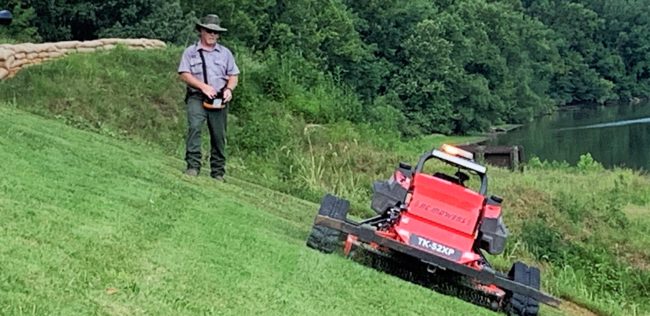
Dover, Tenn. – Visitors to Fort Donelson National Battlefield have long enjoyed and benefited from learning of the site’s Civil War history, experiencing the historic fortifications, artillery, scenic viewsheds, and watching the park’s ever popular bald eagle pair. But since its first appearance on the national park, an odd piece of equipment purchased to enhance safety has become a very popular viewing opportunity for visitors.
The machine that has created the unanticipated interest is a lawn mower. A large, remote-controlled, fifty-two-inch cut, heavy-duty mower, complete with rubber “tank tracks.” To most, the mower appears much like a big zero turn – but without an operator on board. When the machine is in operation, a national park employee can be seen several yards away, with what appears to be a large video game controller in their hands, watching the machine go where traditional mowing equipment cannot.
Fort Donelson Maintenance Worker Kole Labor experiences the visitor interest every time he has the mower in use. “Sometimes you might look up and see one visitor watching the mowing. The next time you look up and there may be a dozen or more people lined along the top, watching the riderless mower handle the slope. It’s very popular.”
After receiving positive reviews about the versatility, safety, and efficiency benefits from other National Park Service sites with similar equipment, the park purchased a model capable of cutting the various types of foliage on its slopes. Put into service in March of 2020, the machine has lived up to the park’s expectations.
“Adding this machine has greatly reduced potential risk to staff, reducing traditional hillside mowing by more than 80%, greatly increasing the efficiency of our mowing operation. For example, under ideal weather conditions it would take five or more employees a full day to weed eat the steep slopes of the river batteries. That same area is now completed with this mower and an operator within two hours, allowing for employees to mow other areas or work on projects,” shared David Hamby, Chief of Heritage Preservation and Maintenance.
For park staff that operate the mower, both training and practice were needed. “For me, operating little remote-control vehicles when younger was helpful for the eye-hand coordination needed to operate this machine,” stated Maintenance Worker Chris Helisek. “While the mower can handle most hillsides and dense growth, we are careful not to mow in delicate resource areas where the mower is too large or where the tracks could possibly cause damage. Those sensitive areas are still taken care of by weed eating,” he added.
As there are not scheduled times for mowing, getting a view of the mower in operation is much the same as watching the park’s wildlife – by chance. Though the machine has been in operation for almost two full seasons, public interest, and the number of “mower paparazzi” continues to grow. As such, park staff request visitor assistance so not to create a new risk, as a spectator. “When someone sees the tank-like machine in action, please do not approach it, maintain a distance, and please do and not stop a vehicle on the road to observe. It is impressive to watch the mower in action, but we ask that everyone does so safely.” Hamby concluded.




